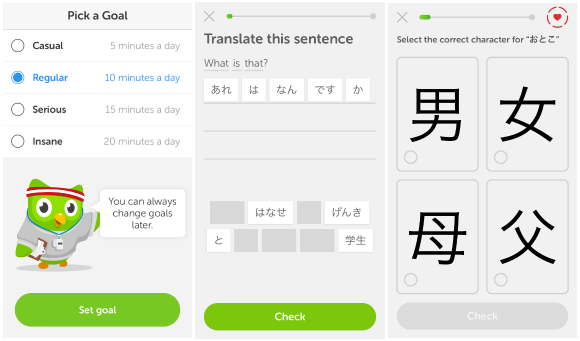
Check out what we thought of the Japanese language course released today!
As a Japanese tutor, one of the most common questions I get from my students is: “What kind of apps can I use to study Japanese on my smartphone?” For a long time the only real recommendation I had was Anki, a program where you made your own flashcards that would be shown to you at different times, depending on how hard or easy they were for you.
While I still think Anki is great, it can be a lot of work. You have to make the cards yourself, and if you ever get off track, getting back on can feel like an impossible task.
But recently we were contacted by Duolingo, one of the largest language-learning platforms in the world, with over 170 million users. As of today (May 19) they’ve released their first Japanese-language-learning course, and they wanted us to check it out.
What did we think of it? Let’s take a look!
▼ Right from the start, you set your own goals at your own pace.
Duolingo’s cute green owl mascot/coach will help you stay on track
▼ If you’ve never learned Japanese before, no problem!
If you have studied it before, then you can test out of early lessons.
▼ We took the placement test, which mostly consists of building sentences.
It’s actually pretty fun to tap the sentence pieces and watch them come together.
▼ Although we do have to admit that some of the
sentence-checkers were a little too strict.
▼ We managed to place out of most of the early lessons (phew!),
but we took a look at the first hiragana lesson, just to see what it’s like.
▼ One cool feature is that they don’t teach hiragana “alphabetically,”
instead they do it in order of building words.
▼ You get to hear each hiragana spoken aloud,
then match the pronunciation with what you hear/see.
▼ Lesson one teaches you the hiragana to spell ichi and ni
(“one” and “two”), which is a really interesting way to do it.
▼ And they constantly throw review questions at you, so that the hiragana
you’ve learned stay fresh and get drilled into your head.
▼ Next we tried an “intermediate” lesson,
one that teaches vocabulary and kanji.
▼ Similar to hiragana, you hear the kanji’s pronunciation
spoken aloud, then you match it to what you hear/see.
▼ There are also some “brain-drilling” quizzes, which help reinforce
meanings in your head by giving helpful pictures.
▼ And in addition to learning new kanji, you also get to review
old ones, keeping them fresh and strong in the ‘ol brain.
▼ If you do poorly in the lessons/quizzes though,
then you lose health.
▼ Thankfully you can earn back health points
by passing a refresher quiz, or just by waiting.
▼ …although sometimes we do have to admit
we felt like we were being trolled.
▼ And once you progress past the intermediate lessons about food,
people, places and more, there’s a special “subculture” lesson…
▼ …and an “Olympics” lesson too.
Perfect for if you’re planning on traveling to the 2020 Tokyo Olympics.
After playing around with Duolingo’s Japanese course for about an hour, I have to say that it’s something I would be happy to recommend to my beginner/intermediate students. It’s not perfect and it had a few kinks in it (sometimes the audio was too slow or incorrect), but overall the nitpicks that I have are outweighed by what it does well.
It has a great user interface, a fun/addictive playstyle that makes you forget you’re even learning, and a sense of accomplishment and progression that is very helpful for students at most levels. I really like the fact that it not only introduces new concepts but constantly repeats old ones to refresh them in your head, and that it sends you daily reminders so that studying becomes a fun habit rather than a dreaded chore.
If you’d like to try it for yourself, then go ahead and download Duolingo on its iTunes page (currently iOS only, Android release next week). In the end, no one single app will teach you all the Japanese you need in order to become fluent, but Duolingo is a good start and a great way to get some daily practice in.
Images: ©Duolingo via Duolingo, Duolingo Press Release